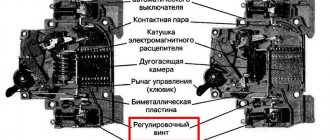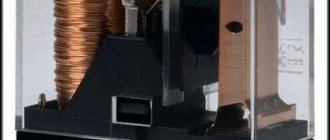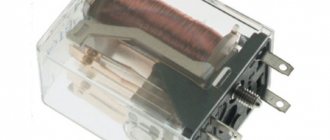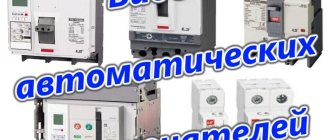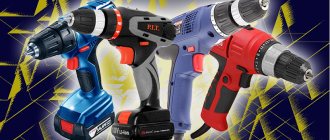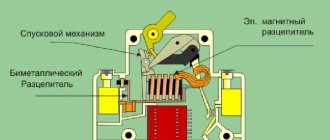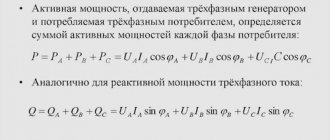The correct selection of a circuit breaker release will protect electrical equipment, safety equipment and distribution network wiring from overload and short circuit overcurrent. One or more releases with different selectivity are installed in circuit breakers (AB). These components protect the electrical circuit from overcurrent and short-circuit overcurrent. There are relay protection devices with instantaneous release and delayed operation.
Types of circuit breaker releases
The load circuit protection device is a direct-acting relay capable of recognizing the onset of an emergency and preventing the development of negative processes. There are several types of tripping devices:
- releases with overcurrent protection and fixed factory settings (thermal components with time delay and electromagnetic instantaneous ones);
- devices for selective recognition of overload from short circuit with settings for rated current and delay time (semiconductor, electronic);
- components with extended functionality (independent, minimum and zero voltage).
Thermal
Thermal release is a bimetallic plate made of 2 strips soldered (welded or riveted) together. The materials for the strips are selected in such a way that the coefficient of thermal expansion of one differs from that of the other. When electricity passes through, the bimetallic joint heats up more, the greater the current in it. If the metal of the bottom strip elongates less when heated than the metal of the top, the bimetallic strip will bend downward.
At a certain current value, bending the plate is enough to open the contacts of the machine. The thermal release reacts to overload ≥30% of the rated current value, therefore it is used for overload protection. The response time is inversely related to the amount of current passing. In different communication devices it ranges from seconds to 1–2 hours.
Electromagnetic
The electromagnetic component is a coil (solenoid) with a core that moves under the influence of the electromagnetic field of the current passing in the winding. The core, overcoming the resistance of the spring, triggers the element that disconnects the circuit. Direct-acting electromagnetic relays recognize a short circuit (exceeding the current value by several times the rated value) and, depending on the response sensitivity, the machines are assigned classes A, B, C and D.
Most often, class B and C circuit breakers are used in household networks, in which the trip delay is designed for 3–10 times the rated current.
Releases of this type operate in a fraction of a second and are instantaneous elements, used for protection against short-circuit currents.
Thermomagnetic or combined
Often the thermal and electromagnetic releases are connected in series. The tandem provides current selectivity: one element monitors currents in the overload zone, and the other protects electrical circuits from short-circuit overcurrents. Some manufacturers call this combination a combined release. In foreign catalogues, a series connection of 2 devices is called a thermomagnetic release.
Semiconductor
The semiconductor device is built on a measuring element IE and an actuating element - an electromagnet with a control unit. The measuring element is assembled on a current transformer.
The electromagnet acts on the free release mechanism of the machine, causing the circuit to open ↔ close. The release is triggered when a current flows in the circuit that exceeds the overload or short circuit setting. This setting is used as an additional protection to the main short circuit overcurrent protection.
The settings for the overload current (1.25–6.0 of the rated current) and overload time (4–16 seconds) of the semiconductor release are indispensable in the home electrical network. They allow you to flexibly configure the operation of the machine when powering the SBT with electric motors, taking into account the high currents at the moment of starting the household unit.
The required current and time delay values are set using switches. They are located on the front side of the control unit.
Electronic
The electronic analog block diagram does not differ from the semiconductor release. The measuring device measures the AB current using a circuit on the transformer. The electronic module of the control unit compares the received and set value and supplies the control voltage to the electromagnet.
An expanded set of options allows for logic selectivity using a controller built into some devices. The electronic release is distinguished by the presence of a current indicator, a large selection of settings and maximum accuracy in following the assigned task.
Independent
The independent type release remotely controls the switching of alternating (AC) and direct current (DC) electrical circuits, representing a conventional release with a distance protection option. The voltage coming through the control circuit, for example from the operator's console, is supplied to the solenoid. A magnetic field is created in the winding, the core is retracted and actuates the free release mechanism in a time of ≤0.04 s. To reset the circuit breaker, you must manually press the button labeled “Reset.”
Undervoltage and overvoltage release
Some AVs are equipped with additional minimum and zero tripping devices, which are built directly into the machine or mounted outside the housing.
This type of release responds to a voltage threshold rather than a current threshold. They turn off the automatic switch when the voltage in the electrical circuit drops below 0.35–0.7 and 0.1–0.35 of the rated voltage, respectively.
Briefly about selectivity
According to the rules: the protection must ensure that the damaged section is disconnected during a short circuit at the end of the protected line.
Roughly speaking, you cannot place a circuit breaker with a lower rating above a circuit breaker with a higher rating of the thermal release. That is, a hierarchical chain must be observed. So that when the machine is triggered, only one section of the circuit where the short circuit occurred is switched off.
In the photo above they are 32 and 25, respectively; 32 and 16. Selectivity is maintained. But this version of the shield is not a good example of assembly, this is just to understand the essence. The customer had only 2 circuits (power and light), and he did not want to change the wiring.
Moreover, this also applies to the characteristics of EMR. You cannot place B above a circuit breaker with characteristic C. If you have several powerful consumers, then category D is selected for the input circuit breaker. So that when several installations with a large starting current are started simultaneously, the input circuit does not turn off. Although in those areas the automation will not work, because the short circuit currents did not exceed them.
I hope you found this article on our website helpful!
Phenomena caused by overcurrents
The flow of extreme current causes the following adverse effects:
- Thermal overheating damages the insulation of conductors and operating components and causes fires. The development of this phenomenon is blocked by installing a current protection device with a response speed of ≤ 0.005 s.
- The electrodynamic force deforms and destroys conductive components, causing breakdown of the switching device. The way to combat this is to select components with increased electrodynamic resistance and correct arrangement of parts, excluding mutual EM influence.
- The magnetic field negatively affects the operation of measuring instruments, computers and other precision equipment. The impact of the field is minimized by using screens made of soft magnetic alloys (permalloy, ferrite).
How to choose the right device?
The most important thing to consider when choosing a circuit breaker is the value of the rated current (i.e., what the load on the network will be). It is not recommended to choose a switch with too much margin for this characteristic, since it may simply not cope with its task (it is too late to break the electrical circuit when damage to the electrical equipment has already been caused).
After determining the current strength, you should select a class (type of release) . It shows how many times the rated current must be exceeded before the machine operates. This parameter is denoted by a Latin letter:
- A - 2-3 times excess - suitable for installation in buildings with extensive wiring;
- B - 3-5 times excess - in residential buildings and apartments;
- C - 5-10 times excess - in workshops and enterprises where a lot of electrical appliances are connected at the same time;
- D - 10-20 times excess - installed in factories (as with group C circuit breakers);
The number of poles also plays an important role , since this characteristic depends on the number of phases in the building. For a single-phase network, single-pole switches (for TN-C, TT power networks) and two-pole switches (for IT power networks) are suitable. For a three-phase network - three-pole (for TN-C, TT, IT power networks) and four-pole (for TN-S power networks).
Checking the functionality of releases
The functionality check includes the following steps:
- Visual inspection of the switch. There should be no mechanical damage on the device body: chips or cracks. Pay attention to the tightness of the parts, the quality of fasteners and clamps. Make a few test manipulations of “on ↔ off” manually. In the on position, the device should click into place and then turn off freely.
- Loading the device. The test consists of determining the response time of the release when power is supplied with an adjustable current strength on a special stand. The obtained result is compared with the typical time-current characteristic of the AB model.
The modern market of electrical equipment offers the consumer a wide range of releases. These devices are equipped with devices of 1-3 phase alternating AC and direct current DC and voltage up to 1000 V.
Correct ways to control shunt releases
APS output expander for controlling actuators /B
The task of controlling 12/24V actuators has been worked out more thoroughly by manufacturers of fire alarm systems.
This is not surprising, because there are many more types of low-current actuators than 220V actuators.
The same voltage outputs of the OK type (open collector) are suitable here as for controlling warning devices and evacuation displays.
Therefore, the task of organizing a control circuit for a low-voltage independent release seems simpler than for a high-voltage one.
Number of poles
As already mentioned, the circuit breaker has poles - from one to four.
Selecting a device for a circuit based on their number is not at all difficult; you just need to know where different types of AVs are used:
- Single-pole circuits are installed to protect lines that include sockets and lighting fixtures. They are mounted on the phase wire without touching the neutral wire.
- The two-terminal network must be included in the circuit to which household appliances with sufficiently high power are connected (boilers, washing machines, electric stoves).
- Three-terminal networks are installed in semi-industrial networks, to which devices such as well pumps or auto repair shop equipment can be connected.
- Four-pole AVs allow you to protect electrical wiring with four cables from short circuits and overloads.
The use of machines of different polarities is shown in the following video:
Principle of operation
The essence of the operation of an independent release device is based on changing the arrangement of contacts. This happens due to the arrival of a short pulse from the diode rectifier. In this case, a transistor acts as a conductor. The switch frequency is adjusted using a modulator. To combat electromagnetic interference, a kenotron is used.
Automatic release PH 47
Externally, the device is a housing made of wear-resistant plastic. The activation button is located on the front of the system. There is a locking latch on the back of the unit and screw terminals at the bottom.
In normal operation, the device passes a current that is equal to the rated value (it can also be less). The top terminal carries the supply voltage from the external network. After this, the current is supplied to the thermal switch, then to the electromagnetic switch. If an emergency occurs, the release disconnects the protected circuit and turns off the machine.
Important! Most often, the system is triggered by a short circuit.
Separation according to rated breaking capacity
According to the criteria that determine the value of the short circuit current at which the circuit breaker will trip and subsequently cut off the voltage supplied to the consumer, three types are distinguished:
- 4.5 kA (4500 A). Most often used to protect power lines of private residential buildings with a resistance of 0.05 Ohm. Such models are practically not used; some countries have already banned their use.
- 6 kA (6000 A). Used to prevent short circuits in public places and residential areas where the resistance is approximately 0.04 ohms.
- 10 kA (10000 A). The machines are designed to protect electrical equipment for industrial use.
For domestic purposes, 6000 A is most often used.
